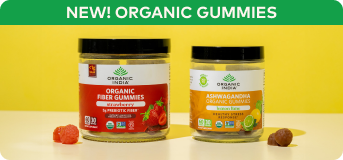

Section

Back
Holy Basil, also known as Tulsi, is an ancient and revered Ayurvedic herb.
Popular in supplements and teas for its adaptogenic qualities, people from all over the world enjoy Tulsi to promote relaxation, alertness, and overall well-being.
As the name implies, Holy Basil is considered a sacred herb; therefore, its uses go far beyond just stress management and the physical body.
In this article, you’ll learn some lesser-known Tulsi uses for promoting physical, energetic, and spiritual well-being.
What is Holy Basil?
Holy Basil, also known as Tulsi, “the queen of herbs,” “the elixir of life,” and “the incomparable one,” is one of Ayurveda’s most ancient, sacred, and cherished functional plants.
It has been used for thousands of years as an adaptogen (a type of herb that helps the body thrive under stress) and rasayana (a tonic-like rejuvenative herb) to support various aspects of health, including:
- Respiratory System
- Digestion
- Ear and eye health
- Energy
- Focus
- Immunity
- Inflammatory response
- Liver function
- Metabolic function
- Nervous system function
- Pain management
- Skin health
- Stress
- Urinary function
Modern analytical researcher has identified several active plant compounds in Tulsi leaves, aka Holy Basil, including:
- Eugenol: The primary active plant compound at the core of most Holy Basil research studies. It’s best known for its antioxidant properties that may support normal inflammatory response, microbiome function, and respiration function. It is also what gives Tulsi its sweet-floral scent.
- Ursolic acid: This is a triterpenoid that supports normal immune regulation and promotes feelings of relaxation and energetic well-being.
- Rosemarinic acid: An antioxidant that supports normal inflammatory response, neurological function, nervous system function, and other aspects of well-being.
These and other constituents such as quercetin, apigen, luteolin, and linalool are just a few examples of the main active plant compounds in Tulsi leaves that are responsible for its many historical benefits.
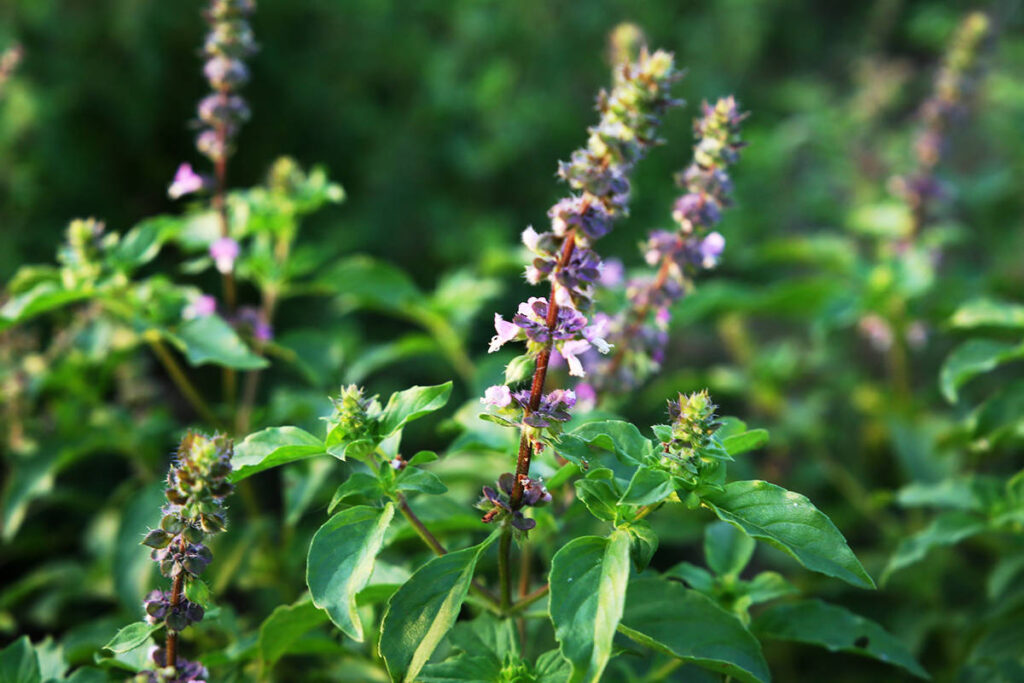
Why is it called Holy Basil?
As mentioned previously, the name Holy Basil is indicative of this herbs’ long-standing reputation as a mystical and spiritual plant.
Some examples of spiritual uses for Holy Basil include:
- Holy Basil is believed to embody spiritual purity and is recognized as a sacred plant in Hinduism.
- It is also believed to be a manifestation of the goddess Lakshmi (Tulsi, where it gets its other name), the main consort of the god Vishnu, and thus, considered a threshold between heaven and earth.
- It is used in daily worship by believers of Vishnu, and caring for the plant is considered an act of worship.
- It is said Lord Krishna wore a garland of holy basil leaves and flowers around his neck. Hence the Krishna variety of Holy Basil.
- Many families in India plant Holy Basil in their yards for protection, good fortune, and as a sign of piety and purity.
- Holy basil is even recorded in the Bible and is used in Orthodox Christian ceremonies, including the preparation of holy water.
- It is used in temples and shrines to purify energy.
- Yogis also revere Holy Basil as a tool to enhance meditation practices and help ease physical soreness.
Holy Basil is a perfect example of how much we can learn about an herb by studying its name.
What can Holy Basil be used for?
As you’ve likely gleaned already, Holy Basil is one of Ayurveda’s most versatile plants and can be used for many physical, energetic and spiritual benefits.
Here, we share the top five Holy Basil uses.
Top 5 Holy Basil Uses
Although Holy Basil is recommended for hundreds of reasons in Ayurveda, here we share five ways you can use it to uplift body, mind, and spirit.
Holy Basil Use #1: Use it to create your own tea rituals
Holy Basil’s robust yet delicate sweet, floral, and pungent flavor along with its health benefits make it a popular herbal tea.
It’s also used in sacred tea rituals, which you can practice at home no matter what your religion or beliefs.
Creating a tea ritual doesn’t have to be complicated.
Simply choose a tea that calms and uplifts, like Holy Basil, set an intention for your tea time, and prepare and sip it mindfully as you maintain a state of presence, gratitude, and acceptance.
The great thing about tea is it takes at least fifteen minutes to prepare, steep, cool a bit, and sip, so it’s the perfect medium for daily meditation.
Learn more in: Tea Meditation: A Sacred Sequence to Try

Holy Basil Use #2: Try it post-exercise for physical, mental, and emotional benefits
One of the lesser-known uses of Holy Basil is for easing minor physical discomfort , such as you may experience a day or two after exercising.
This is thanks to its antioxidant properties, which have been shown to support normal inflammatory response.
As a sattvic herb (one that brings light and perception) it’s a wonderful balm for the soul, making it the perfect tea to turn to when you need more light, clarity, and joy in your life.
Finally, its studied benefits for neurological function make it a wonderful rejuvenator for tired minds or over-thinkers.
The ideal tonic for body, mind, and heart.
Holy Basil Use #3: Grow your own for protection, good vibes, and pollinators
Like sweet or Italian Basil, Holy Basil grows easily in spring and summer in most climates.
Its intense sweet scent and beautiful purple flowers make it a gorgeous addition to any herb, vegetable, or ornamental garden.
Tulsi plants are believed to be high-frequency in energy, meaning they help purify and uplift a space while enhancing its calming and welcoming atmosphere.
Many people feel this energy when they walk by a plant, or rows, of Tulsi.
You can also harvest your own Tulsi leaves to use in recipes (more on this below), teas, homemade tinctures, or personal care products.
Finally, if you’re passionate about pollinators (like us) there is no better plant to lavish on them than Tulsi.
Bees, including honeybees, absolutely love its purple tops and will feast on the pollen for weeks at a time.
It also attracts butterflies, hummingbirds, and other beneficial insects that will enhance the health of your garden and entire community ecosystem.
Learn how to grow your own in: How To Grow Tulsi (Holy Basil)

Holy Basil Use #4: Incorporate Tulsi into your Skincare Routine
Tulsi’s antioxidant properties make it an incredible herbal ally for clear, clean, and ageless skin.
You can find Tulsi in Ayurvedic skin care products, or make your own.
For example:
- Tulsi tea can be applied to a cotton ball or used in a spray bottle (use immediately or refrigerate and use within 2-3 days) and applied to the face as a gentle toner.
- Dried tulsi leaf can be added to chickpea flour or your favorite clay and used as a daily cleanser.
- Fresh Tulsi can be pulverized and mixed with honey or yogurt and used as a DIY face mask to soothe breakouts, irritation, or redness.
Get more tips on using Tulsi for beauty in: Topical Tulsi for Beautiful Skin
Holy Basil Use #5: Use it in your recipes
Ayurveda has always promoted the use of functional herbs and spices in everyday recipes.
This adds incredible flavor to foods and beverages, and tasting the herbs is believed to be an important part of reaping their full benefits.
At Organic India, we’ve created dozens of Tulsi recipes to help you get the full experience of this beautiful herb.
Tulsi tastes a lot like sweet or Italian Basil but with sweeter and more floral notes. It’s delicious in sweet or savory dishes (like stir fries, curries, or salad dressings) and makes a lovely addition to beverages too.
Some of our most popular Tulsi recipes include:
- Tulsi Sweet Rose Spritzer
Holy Basil Blueberry Pie with Fresh Basil – Organic India - Gluten-Free Vegan Pumpkin Cheesecake With Tulsi Chai
- Strawberry Tulsi Hibiscus Sorbet
- Golden Late With Tulsi Turmeric Chai

Discover More Tulsi Uses to Support Your Health
Tulsi has been at heart of Organic India’s offerings since our inception, which is why we are so passionate about sharing its benefits.
All our Tulsi teas and supplements are sourced from regenerative organic herb farms owned and run by local Indian growers.
This ensures the highest quality and highest frequency Tulsi in every capsule, sip, or bite.
If you’d like to experience the many uses of Tulsi, we invite you check out some of our most beloved products, including:
- Tulsi Original Tea
- Tulsi Original Tea in Bulk (great for customizing teas, DIY tinctures or skincare, or culinary recipes)
- Tulsi Sweet Rose and Tulsi Sweet Rose Assam Black Tea
- Tulsi Masala Chai Tea
- Tulsi Sleep Tea
- Tulsi Holy Basil Supplement
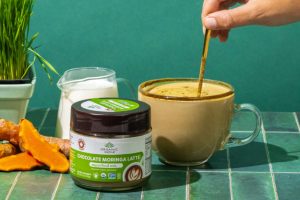

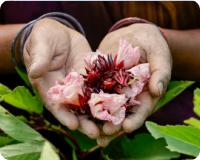

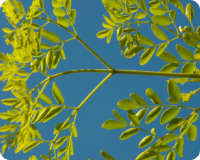

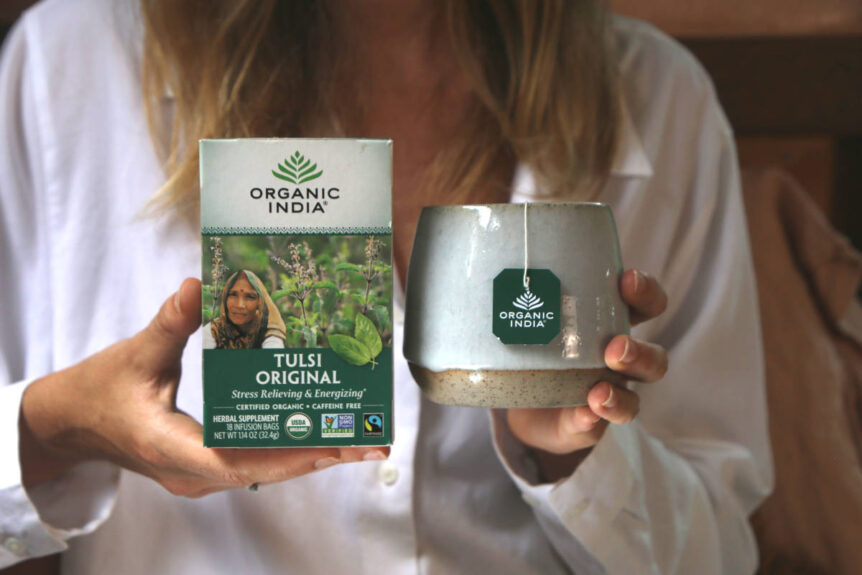
 Kristen Boye is a freelance natural health and green living writer, copywriter, and editor. Kristen was raised on an organic farm in British Columbia which inspired her life’s work. She holds a Bachelor’s Degree in Natural Health, is a Certified Natural Foods Chef, a medicinal herb farmer, natural foods advocate, and is obsessed with writing, homesteading, researching, regenerative agriculture, and words in general. Kristen lives with her husband and two children on their medicinal herb farm in Western North Carolina
Kristen Boye is a freelance natural health and green living writer, copywriter, and editor. Kristen was raised on an organic farm in British Columbia which inspired her life’s work. She holds a Bachelor’s Degree in Natural Health, is a Certified Natural Foods Chef, a medicinal herb farmer, natural foods advocate, and is obsessed with writing, homesteading, researching, regenerative agriculture, and words in general. Kristen lives with her husband and two children on their medicinal herb farm in Western North Carolina